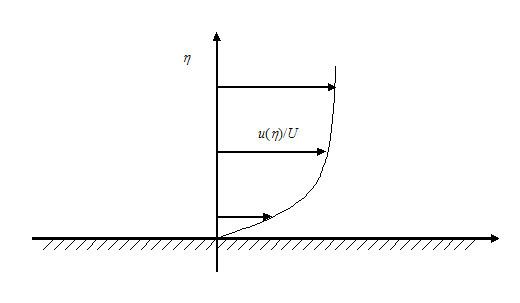 | ||
In physics and fluid mechanics, a Blasius boundary layer (named after Paul Richard Heinrich Blasius) describes the steady two-dimensional laminar boundary layer that forms on a semi-infinite plate which is held parallel to a constant unidirectional flow. Falkner and Skan later generalized Blasius' solution to wedge flow, i.e. flows in which the plate is not parallel to the flow.
Contents
Prandtl's boundary layer equations
Using scaling arguments, Ludwig Prandtl has argued that about half of the terms in the Navier-Stokes equations are negligible in boundary layer flows (except in a small region near the leading edge of the plate). This leads to a reduced set of equations knows as the boundary layer equations. For steady incompressible flow with constant viscosity and density, these read:
Continuity:
Here the coordinate system is chosen with
These three partial differential equations for
or, after differentiation:
Here
Substitution of these results into the
A number of similarity solutions to this equation have been found for various types of flow, including flat plate boundary layers. The term similarity refers to the property that the velocity profiles at different positions in the flow are the same apart from a scaling factor. These solutions are often presented in the form of non-linear ordinary differential equations.
Blasius equation
Blasius proposed a similarity solution for the case in which the free stream velocity is constant,
Where
in which the newly introduced normalized stream function,
Where the prime denotes derivation with respect to
This is a third order non-linear ordinary differential equation which can be solved numerically, e.g. with the shooting method.
The boundary conditions are the no-slip condition
impermeability of the wall
and the free stream velocity outside the boundary layer
Falkner–Skan equation
We can generalize the Blasius boundary layer by considering a wedge at an angle of attack
Where
As in the Blasius solution, we use a similarity variable
It becomes easier to describe this in terms of its stream function which we write as
Thus the initial differential equation which was written as follows:
Can now be expressed in terms of the non-linear ODE known as the Falkner–Skan equation (named after V. M. Falkner and Sylvia W. Skan).
Here, m < 0 corresponds to an adverse pressure gradient (often resulting in boundary layer separation) while m > 0 represents a favorable pressure gradient. (Note that m = 0 recovers the Blasius equation). In 1937 Douglas Hartree showed that physical solutions to the Falkner–Skan equation exist only in the range -0.0905 ≤ m ≤ 2. For more negative values of m, that is, for stronger adverse pressure gradients, all solutions satisfying the boundary conditions at η = 0 have the property that f(η) > 1 for a range of values of η. This is physically unacceptable because it implies that the velocity in the boundary layer is greater than in the main flow.
Further details may be found in Wilcox (2007).
